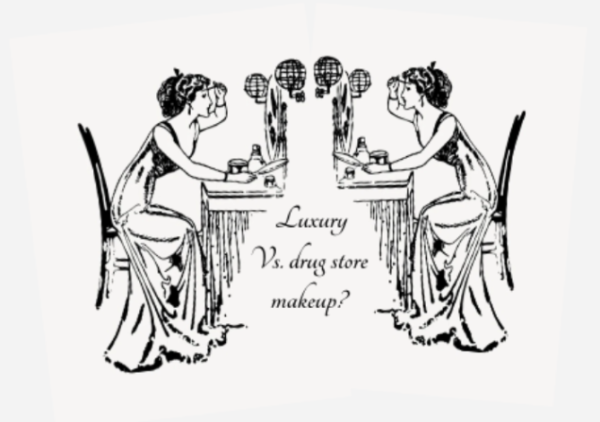Nail salons 101: Safer and healthier approaches

Source: https://img.freepik.com/premium-vector/set-manicure-clipart_25030-52537.jpg
Nail salons are one of the most common places that come to mind when you think of a way to pamper yourself. From elementary-age girls all the way into adulthood, this experience is one that most girls have tried at least once in their lifetime.
A nail salon is defined as an establishment that primarily offers nail care services such as manicures, pedicures, and nail enhancements.
There’s a lot more that goes into these salons than its literary definition.
Walking into a nail salon will most likely result in you sitting on one end of a table with a nail technician directly across from you. You select whichever color you desire for your manicure, the type of service you would like, the shape you want your nails to be, and the designs on top of the nail. Essentially, you have full creative freedom when it comes to choosing what you want your nails to look like — you just have to pay the price.
Nail salons are viewed as a fun activity, and to some, an essential part of one’s appearance.
Though frequent nail salon clients have been saying that it’s a fun way to treat yourself for years, they’re now not so sure.
From acrylic nails, gel manicures, and dip-powder extensions, nail services consist of many toxic materials that are absorbed into your skin each time you get your nails done. The health risks that come with getting any nail service can range from unsanitary tools, exposed wounds, or allergic reactions to harmful chemicals. Every nail service begins with cutting off your cuticles and filing off the top layer of your nails to create a base “suitable” for keeping the artificial nails on for an extended period of time.
After filing off the top layer of your nail-depending on your service of choice- plastic extensions are glued onto the tips of your nails or acrylic is used to mold a fake nail over your own. Then, a filing drill is used to make your natural nails look seamless with the artificial nails, and gel polish, SNS powder, or different colored acrylic is placed on top to embody your desired look.
The process typically takes around an hour, and though you may walk out of the salon feeling satisfied with the look of your nails, nobody seems to speak about the damaging effects that occur throughout the service.
According to the American Academy of Dermatology Association, “Gel manicures can cause nail brittleness, peeling and cracking, and repeated use can increase the risk for skin cancer and premature skin aging on the hands.”
Gel is the most common service at nail salons. Gel nails allow your manicure to last much longer, are much stronger, and less susceptible to breaking like acrylics. However, gel nails still require the filing off of the top layer of your nail, which causes damage and peeling. The nail becomes more fragile, and as a result, thinner. The filing is done to ensure that the gel has a gripped surface to cling onto, which is why it lasts so long.
High school junior, Ashley Tavarez, speaks on her experience getting a gel manicure:
“My nails felt very brittle and soft when I got the gel taken off; which is very out of the ordinary as my nails are very durable compared to others. It also felt very weird even doing mundane things like washing the dishes. They felt so weak that I thought they would break off any minute.”
Iphigenia Petra, a high school freshman who gets her nails done often, looks back on a bad experience she had at a nail salon not too long ago. She states, “My previous experience getting my nails done was very awful. I had a set beforehand, but they were really overgrown so I had to get them redone. Every two weeks you have to get your nails redone because the growth on your nails basically ruins the gel. I had them on for about a month at this point and my nails were pretty fine, but I chose a different salon than the one I usually go to. It was cheaper, I didn’t expect much of a difference. Regardless, when I sat down the filing was really bad, my nails were breaking. They kept trying to cut my nails and file them more but they just turned my nails into a bad shape. The gel and paint job was just really bad and my nails kept on getting ruined, and within two weeks my nails started to chip off and break, which isn’t supposed to happen.”
Aside from the filing process, which is done for most nail services, gel nails require the soaking of your nails in acetone. An article on the health side effects of a manicure writes that “a study from the Miami School of Medicine found that gel manicures do cause nail thinning, from both the chemical composition of the polish, as well as the acetone soaking process during removal.”
The article continues, stating that “if gel polish does not come off easily after soaking in acetone, you know something’s wrong. The same goes for if your cuticles are cut or removed in prep for a manicure.”
A typical form of “prepping” your nails for a service is cutting off your cuticles. It is said that doing this will make the manicure look better and cleaner. But in reality, it’s very bad for your health as it makes your body more prone to infection.
“Nail technicians can be rough on your nails during a manicure and pedicure. With nail clipping, cuticle cutting and nail filing, it’s easy to get skin lesions. The most common infection caused by these cuts to your skin is paronychia, which is a bacterial infection of the hard skin surrounding your nail,” writes an article on the health risks of getting your nails done.
Junior Aseel Ahmed speaks about how she notices the harmful effects the different substances used for nail services can have on you. She mentions a first-hand experience: “I’ve heard a lot about the harmful effect of getting acrylics or SNS on your nails and I definitely see it as well. I know it does make your nails much weaker and susceptible to breaking. It can also damage the skin around your nails and the cuticle. In one experience, I took my nails off and my nail was so thin that it hurt to press down on it and you could like, see the blood underneath the nail. So yeah, there are definitely many harmful effects of getting your nails done.”
Additionally, salons use “UV” or LED Lamps to cure your nails. After using the gel, you place your hand under the blue light so that the gel can harden. Though it does not seem harmful at first, these UVA rays are extremely dangerous.
Petra says, “I know that our nails are really absorbent of a lot of chemicals, so the nail glue that gets used, the UV gel, and curing it actually all gets absorbed by your body so it’s a really bad side effect to getting your nails done. I also know that the UV light itself that uses blue light to cure the gel is supposed to be really harmful for your nails. I haven’t really seen my nails getting weaker because of it but I do know that it is scientifically proven to be bad for you.”
In fact, an article on the Top 5 Health Risks at Nail Salons states that “drying your nails under the UV light seems like a no-brainer, but the consequences can be severe. Although long-term research is needed, dermatologists’ main concern with UV light is the possibility to develop skin cancer or tumors. Additionally, the areas of skin exposed to UV light are susceptible to aging.”
Aside from the harmful chemicals and UVA rays, your health is at risk if your nail salon or technician is not properly qualified. Many nail salons can be unsanitary, and can cause an uprising in infection during the process of getting your nails done. If your nail technician is not gentle and seems to be rushing through the process, it is likely that the skin around your nails will get cut. This is harmful because open wounds are a gateway to infections that come from the substances or unsanitary tools they use.
Sophomore Naima Gomez speaks on the experience she had while getting her nails done by a nail technician who did just that. She states, “I don’t remember how long ago this was, I think it was a while ago, but one time there was this lady who was cutting my nails. My nails were kinda short because for a while I had a really bad problem with biting them, but the lady who was doing my nails was really aggressive when cutting and filing. She filed my index finger so insanely short to the point where it hurt. I was way too nervous to say anything about how she was cutting and filing so I remained silent, but I remember it hurt a lot.”
High school junior Isabella Chan agrees, and is reminded of a time when a friend of hers had a similar experience at a nail salon. She recalls, “one of my friends went to get her nails done and they filed her nails a lot, like all the way down to her nail bed. They put the acrylic nails on and they grew out really weird. My friend got a really bad infection from the tools they used on her.”
She continues by saying that she has “heard some bad things about getting your nails done, like getting infections and all that. [Her] nail salon uses sanitary and new products for each person, but [she] know[s] a lot of salons don’t do that, and they probably reuse a lot of tools. For gel nails, you’re supposed to soak your nails in acetone beforehand, but some nail techs are just lazy and it’s honestly really bad for your nails.”
An article on the risks of getting your nails done justifies this argument, stating that bacteria, fungi and viruses can be transferred between customers when equipment isn’t disinfected and sterilized.”
This harmful bacteria is transferred through cuts in the skin, and is the main reason you should be concerned if your nail begins to burn, your skin starts to bleed, or you feel as if you have been cut.
“Acrylic nails, nail glue and nail polish can cause allergic contact dermatitis, a rash that appears after exposure to an allergen… Plantar warts are another skin condition that can develop at nail salons. Like mycobacteria, plantar warts thrive in warm, moist environments and can be contracted through cuts in the skin,” writes an article on the harmful effects of nail salons.
So yes, nail salons can be bad for you — everybody is well aware of it. But the question is: then why do people still continue?
Harmful health risks come with doing anything “too much.” From using your phone, putting on makeup, exercising too much… the list goes on. So do these harmful effects really matter? To some, the answer may be an obvious yes, but to others, not so much.
After consulting with each of the teen girls about what they knew of the negative effects that come with getting their nails done, I flipped the perspective. Do you still get your nails done? Why do you continue? What causes you to look past the negative side of it all? Almost all the responses were identical.
Ahmed states, “I do still get my nails done because I am very lazy and really like having acrylics. I honestly love the look of acrylics and how nice the designs are. It makes me feel more put together and it’s just really nice to pamper myself with them, especially if there is a holiday or wedding where the nails go with my outfit for the day. So yes, I still get them done.”
Adding on, Gomez expands on the entire reason for loving the way a fresh manicure looks. She responds, “I still get my nails done! I really like the clean feeling afterwards and the look that they have. I also really enjoy getting nail art done when I’m feeling fancy. It’s really cute and nice looking down at my hands and seeing a little Hello Kitty chilling there.”
Though the looks are a huge part of it, that isn’t all that goes into continuing to get your nails done. Petra takes a different approach, and speaks about how getting her nails done at a salon helps her nail growth: “I get them done because I like the look of them, I like how long nails look. Also, by putting the gel on top it actually allows my nails to grow more. If I leave my nails natural without the gel making it thicker, they break very easily.”
From press-on nails and at-home gel kits, to the traditional growing out your nails, there are several alternatives to nail salons that are not only cheaper, but better for your nails in the grand scheme of things.
Though these approaches may work for some, many say that it requires a lot more effort, and though they may give a similar visual result, the practicality does not compare to that of getting your nails done at a salon.
Chan speaks on her experience with testing out different alternatives: “I have tried press-on nails and doing them by myself, but I feel like it wouldn’t last as long, which is why I prefer going out to do my nails. I don’t have to worry about chipping or anything. I like press-on nails, but it’s hard to do certain things because the glue or the edge of the plastic can get stuck in your hair and things like that. I don’t think acrylics are necessarily better, but they do last longer and it’s way easier to have them as opposed to the press-ons.”
Ahmed responds with a similar experience testing out these other methods. She states, “I have tried alternatives to acrylics. I have tried just painting my nails but I hate the length of my nails and they aren’t that healthy either. I bite my nails a lot so they never look nice and putting nail polish on them doesn’t change the fact they look weird. I also tried press-ons to fix that while not having to get acrylics, but they never end up sticking on throughout the day and fall off. I also hate the feeling of them since they are cemented on like acrylics are, and so you can feel the nails on you. I never get the size right and they always end up looking weird since I do them myself, so acrylics were always the way to go for me.”
Each interviewee seemingly had the same common experience of press-ons falling off easily, being hard to maintain, and polish chipping often.
Petra adds to both Chan and Ahmed: “Before I started getting my nails done with acrylic, I used press-ons so that I still had the look of long nails while letting my natural nails grow out a bit. Before that I used to just do my nails on my own, but it’s all way harder to maintain. Like, the press on nails were plastic, so whenever I would try to cook something or do anything really, they would wear down. With the way I do my nails now, that doesn’t happen. I don’t have the UV gel at home so I would just use regular polish for a basic manicure, but it would chip really easily. Essentially, both of those experiences were negative compared to doing them at the salon.”
Gomez agrees with the inconvenience factor of press-on nails. She states, “During 2020, I tried a lot of alternatives to replace that feeling of getting my nails done in person, but none of them worked quite well. Press-on nails for me are very difficult. I tried press-on nails once and it was the most uncomfortable thing. I’m always doing stuff that’s pretty heavy duty; I skateboard and do a lot of DIY things that could involve me using my nails which made press-ons so inconvenient. It was just really annoying. I also tried doing the whole thing on my own, but the moment I applied the first coat of nail polish my mom came in and told me to stop because the smell was giving her a migraine.”
Although each interviewee had their own reasons for loving the entire idea of getting their nails done in a salon rather than the alternatives, they still threw in a few cautionary measures that they take to ensure that nothing goes south.
Chan specifically speaks on the sanitary factor of nail salons. She says, “I still get my nails done because I have a trusted person doing them so it makes me feel more comfortable. If it weren’t for that, I don’t think I would be getting them done. I wouldn’t know if they’re using good equipment on me or if it’s clean.”
Making sure you have a nail technician that you trust and know the credentials of is essential. Not only do you need to feel comfortable in the event that you want to speak up about something, but you trust that their tools are new or at the very least, disinfected.
Petra expresses herself more on the frequency of getting her nails done. She states, “I get my nails done way less than most people do. Most people get them done every two weeks, but I do them once a month to reduce my exposure to all of these chemicals.”
Reducing how often you get a new set or re-do your nails at a salon is a great way to stay healthy while still having the desired look that comes from salon nails.
Ahmed responds in agreement, stating, “I also do my nails very infrequently and get them only for special events, so the effects aren’t as bad on me as someone who gets them routinely.”
If you’re the type of person that does not mind the feel and process of doing your nails on your own, then press-on nails or nail kits would be the healthiest approach for you. This would typically be recommended for someone that does not want to spend as much money on salon prices, doesn’t mind keeping up with the manicure to keep it intact, and does not take part in a lot of hands-on activities. If that sounds like you, you would benefit most from nail salon alternatives!
If that doesn’t speak to you, and nail salons seem like something you aren’t willing to give up, then there are still many ways you can continue to stay healthy without changing your routine:
Make sure your nail salon is sanitary. Check reviews, go to the salon before making an appointment, and ask those around you for references. An unsanitary nail salon typically reuses tools, can spread infections, and cause health complications. This is the driving factor in the “nail salon horror stories” everywhere. Additionally, never let your manicurist push or cut your cuticles, as it can lead to inflammation!
Don’t get your nails done back to back with each set. Your nails need time to recover after each service and rebuild their strength. Instead of refilling your nails or redoing them every two weeks, aim for once a month. This ensures that your nails get a break between salon visits and can grow healthy rather than weaken. Between each set that you get, make sure to moisturize your hands and nails with lotion in order to prevent brittleness, dry skin, and chipped nails.
Before getting a gel manicure, make sure to put sunscreen on your hands. This will protect your skin from the harmful ultraviolet radiation that is emitted from the blue light that cures the gel.
Speak up! It can be hard to build up the courage to say something to your nail tech if something looks wrong, but if you get a cut, your nails start to hurt, or you feel uncomfortable with a part of the process, tell them. They’re skilled in their jobs, and they would know what to do as long as you bring their attention to the problem. This helps avoid infections or pain coming from your service, and keep in mind that it should not hurt to get your nails done!
Whether it’s going to a nail salon to get your nails done or doing them on your own, you can keep yourself safe while still getting the results you desire!











